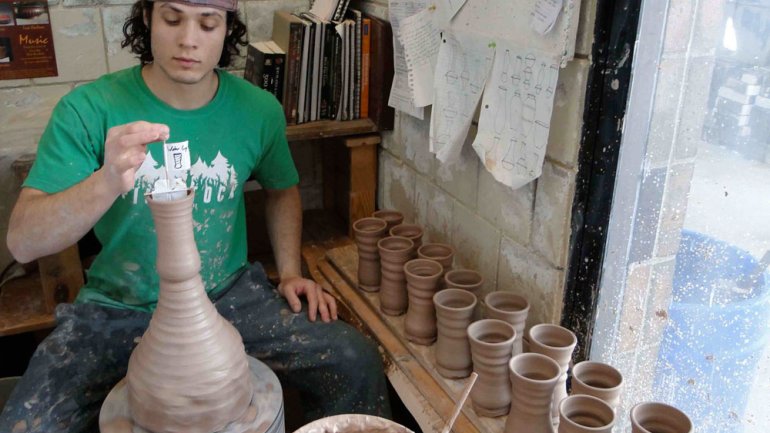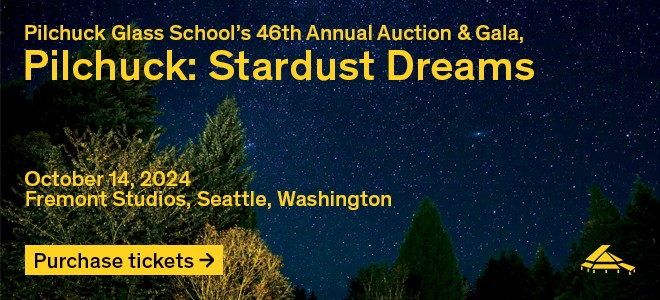Eat, Pay, Love: A Potter's Business Model
Joel Cherrico is a young potter and recent college grad determined to make a living at his craft. We asked him to tell us how he is making it work.
Tell us about your artwork. How did you get into pottery, and how did you become a full time potter?
I started my small business, Cherrico Pottery, after graduating college in 2010. I’ve been a full-time artist for about two years, with a goal of making and selling enough pottery to support my career.
I was an art major at the College of St. Benedict/St. John’s University in Minnesota. My mentors were professor Sam Johnson and local potter JD Jorgenson. Both Jorgenson and Johnson studied with Richard Bresnahan at the St. John’s Pottery, where they learned the Japanese style of pottery making that Bresnahan mastered in a four-year apprenticeship in Karatsu, Japan. The result is a Minnesota style of pottery in tune with the natural world and the local community.
I worked under Jorgenson during my first two years of college. I helped build his 30-foot-long wood kiln, used recycled materials to build parts of his studio, and learned Japanese pottery techniques. During my next two years of college, Johnson taught me about the contemporary ceramic world. We continually discussed aesthetics and what makes a great pot. We experimented with natural gas-firing and wood-ash glazes, and we explored the balance between pottery and sculpture. By my senior year, I felt compelled to pursue a career in ceramics.
I told Johnson that I wanted to make a living from my pottery without having a part-time job. He suggested I take entrepreneurship classes to learn how to operate a small business. By graduation, I had written a 50-page business plan and applied for a post-baccalaureate artist residency at the college. I was accepted to the one-year residency and awarded an $8,000 small business loan to start my venture. That is when I began making pottery for the Local Blend coffee shop.
What makes your business model different from that of other functional pottery makers?
During my entrepreneurship class, I came up with an innovative business model for making pottery to use in a local restaurant. I make cone 10, stoneware pottery, and it’s made to be used. How else could I get my work into peoples’ hands when I don’t have my own studio or showroom?
At the Local Blend coffee shop in St. Joseph, Minnesota, customers can eat and drink from my pottery every day. I filled this small shop with more than 300 pots to use as serving vessels at no cost, and the pottery is also available for sale. The Local Blend takes 25 percent of sales, while paying for any breakage. This has been a sustainable business model, as well as an interactive art installation.
How have sales gone at the Local Blend? Have they met your expectations?
In order to pay my living expenses and pay back my business loans, I need to sell pottery any way I can. I show at a weekly farmers market, six to eight art festivals each year, and four local shops and galleries around St. Cloud, Minnesota. Sales at the Local Blend have been better than all of these venues combined. I’m blown away by the fact that getting people to eat and drink from my pottery results in sales.
I generally have trouble keeping up with the Local Blend pottery supply, especially with coffee mugs. The hardest part of this business model is to make mugs that hold 12, 16, and 20 ounces. Otherwise, that medium vanilla latte won’t taste right. Clay shrinks about 12 to 15 percent throughout the making process, so I had to come up with standard forms for each mug size. The Local Blend uses all of my pottery that is within 1 to 2 ounces of the correct size, and this has worked just fine.
What is the nicest thing you’ve heard about your pottery as a result of your partnership?
The best part of this project is that people can drink from pottery every day for the price of a cup of coffee. At art festivals, someone will pick up a mug and ask, “Can it go in the dishwasher?” That question goes out the window when customers sip their coffee from pottery at a restaurant. Throughout their meal, they also have more chances to notice the subtlety in each pot: my finger marks at the base of the handle, or a small glaze drip at the foot.
Another advantage is that the Local Blend doesn’t have to buy tableware anymore. Employees say they love using the pottery, and that it’s just as easy to work with as machine-made pottery. I make my pieces fairly thick, especially at the lip; this helps to avoid chipping and breakage.
What does the future look like for Cherrico Pottery?
My next plan is to kick my pottery production into high gear. Every time I see a perfect, red mug come out of the kiln, I get the urge to make 100 more exactly like it. I hope to have a surplus of pottery for the Local Blend. Then I may be able to approach another coffee shop, probably in the Twin Cities, with this business model.
Lastly, I hope to return to wood firing in the near future. The Local Blend ordered only glazeware for their shop because they wanted to be able to clean pottery very quickly, multiple times each day. I really enjoy glazed pots, and I will probably always gas-fire to some extent, but I feel compelled to return to my roots. My mentors were wood-fire potters, and this process will always influence my work. However, changing from glossy to rough surfaces would be a huge transition for my process as well as my sales.
I would like to come up with a business model that could sustain my career with the rough, sandpapery surface that I enjoy so much. The Local Blend sales happen because customers experience pottery in a new way. I think that any new wood-fired pottery would have to be highly utilitarian – and something that a user wouldn’t scrape his or her spoon against. My best prospect at this point: planters. So my next challenge might be getting people to experience these in a new way.




